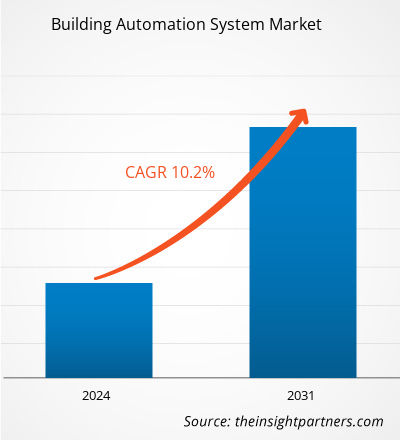预计到2031年,楼宇自动化系统市场规模将从2023年的767.5亿美元增至1674亿美元。预计2023年至2031年期间的复合年增长率为10.2%。消费物联网、基于IP的设备、SaaS和其他技术发展可能仍将是市场的主要趋势。
楼宇自动化系统市场分析
全球范围内不断增长的建筑活动和对智能建筑的需求是推动市场增长的主要因素。楼宇自动化系统使用先进的传感器、执行器和网络技术,对暖通空调、照明、安防、门禁和能源管理等建筑系统进行集中控制和监控。这些技术旨在最大限度地提高建筑效率、降低能耗、简化设施管理程序并确保遵守法规和标准,从而进一步提升楼宇自动化系统市场的需求。物联网 (IoT)、基于 IP 的设备、SaaS、机器学习和其他技术的集成等新兴技术进步也有望在未来几年带来新的趋势。
楼宇自动化系统市场概览
楼宇自动化系统 (BAS) 使操作员能够通过单一界面访问、控制和监控所有连接的建筑系统。BAS 技术允许业主使用联网电子设备对其建筑的运行进行集中管理。为了保持居住者的舒适度,系统会控制通风、湿度、照明和温度。占用传感器和调度功能可在不使用时修改环境系统,从而最大限度地减少能源浪费。此外,它还能确保每个系统都以最佳效率和准确性运行。当需要进行预防性维护时,传感器会通知操作员。建筑物的消防、门禁和监控系统均已集成,以保护建筑物及其人员的安全。
自定义此报告以满足您的要求
您将免费获得任何报告的定制,包括本报告的部分内容,或国家级分析、Excel 数据包,以及为初创企业和大学提供超值优惠和折扣
楼宇自动化系统市场: 战略洞察

- 获取本报告的主要市场趋势。这个免费样本将包括数据分析,从市场趋势到估计和预测。
您将免费获得任何报告的定制,包括本报告的部分内容,或国家级分析、Excel 数据包,以及为初创企业和大学提供超值优惠和折扣
楼宇自动化系统市场: 战略洞察

- 获取本报告的主要市场趋势。这个免费样本将包括数据分析,从市场趋势到估计和预测。
楼宇自动化系统市场驱动力与机遇
对舒适性、安全性和保障性日益增长的需求
楼宇自动化系统通过提供尖端仪器和技术,改善了楼宇的安防系统。它为楼宇内的人员提供了更佳的安防保障,并有助于保护资产、公司资源、财产和 IT 数据。除了防止财产损失和盗窃外,该系统还可以防止员工篡改和盗窃。楼宇内的电梯门禁系统会限制管理人员认为禁止进入的特定楼层和区域。此外,该系统还可以防止安全漏洞,并允许临时流量在设施内疏导。只有授权人员才能通过在门禁管理中使用时间和日期调度限制获得访问权限。此外,门禁软件还会记录和存储物业场地和楼宇内发生的每项活动。此外,该系统还可以编程检测潜在的安全问题,例如气体泄漏或火灾,并采取适当的措施来限制这些风险。
对可持续楼宇自动化解决方案的需求日益增长
可持续建筑旨在最大限度地降低能源消耗和碳排放。BAS 可以根据入住率和环境条件监控、控制和优化暖通空调 (HVAC)、照明和其他系统。随着人们越来越多地转向太阳能和风能等可再生能源,BAS 可以智能地管理这些能源在楼宇运营中的整合和利用,确保最佳能源利用并大幅节省成本。BAS 提供能源使用情况和环境指标的实时数据,帮助制定明智的节能策略决策,并遵守可持续发展标准和法规。可持续建筑优先考虑居住者的舒适度和健康。BAS 可以保持室内空气质量、调节温度并优化自然采光,从而提高居住者的满意度和工作效率。此外,可持续的 BAS 解决方案还可以通过降低能源支出、减少维护需求和延长设备寿命来节省成本,这对建筑业主和运营商来说具有经济吸引力。采用可持续解决方案符合全球可持续发展目标,能够提高能源效率,提升居住舒适度,并为建筑业主和运营商带来显著的经济效益。因此,各行各业对可持续楼宇自动化解决方案日益增长的需求预计将在预测期内为楼宇自动化市场的增长创造巨大的机遇。
楼宇自动化系统市场报告细分分析
促成楼宇自动化系统市场分析的关键细分市场是组件和最终用户。
- 根据组件,市场细分为硬件、软件和服务。硬件细分市场在2023年占据了更大的市场份额。楼宇自动化硬件使用传感器和控制器来监控和调节建筑的公用设施,即电力、供暖和空调以及水和污水处理系统。楼宇自动化系统的硬件组件包括恒温器(用于控制室温)、占用传感器(用于控制照明)、湿度传感器、火灾和烟雾探测器以及安防和监控系统。硬件市场进一步细分为安防监控系统、设施管理系统、消防系统等。提供楼宇自动化硬件的公司包括博世安全系统有限公司 (Bosch Sicherheitssysteme GmbH)、路创电子有限公司 (Lutron Electronics Co. Inc) 和特灵 (Trane)。
- 根据最终用户,市场细分为商业、工业和住宅。2023 年,商业领域占据了市场主导地位。在商业建筑中,楼宇自动化系统 (BAS) 用于根据入住率、季节或其他重要参数来管理内部温度和照明。楼宇控制系统调节供暖、制冷设备和照明系统的运行,以维持良好的环境,从而刺激设施内指定人员的工作效率,同时在某些区域不使用时节约能源。此外,使用商用楼宇自动化系统 (BAS) 已被证明对维护和管理人员大有裨益。由于系统和组件性能会定期受到监控,因此一旦检测到异常,团队就会收到通知。
按地区划分的楼宇自动化系统市场份额分析
楼宇自动化系统市场报告的地理范围主要分为五个区域:北美、亚太地区、欧洲、中东和非洲以及南美和中美。
2023 年,北美占据楼宇自动化系统市场的最大份额,其次是欧洲和亚太地区。由于整个地区建筑活动的增加以及多个州的经济增长,北美市场在预测期内可能会增长。楼宇自动化系统被广泛用于实现能源效率,因为这与财务节约直接相关。美国和加拿大等国家正在快速建设智慧城市,预计这将为预测期内楼宇自动化系统市场的增长提供机会。
欧洲的建筑业经历了巨大的增长,主要是在新建筑方面,预计这将提振该地区的楼宇自动化系统市场。欧洲建筑业在经济中扮演着重要角色,雇佣了约1800万人,占欧盟GDP总量的9%。该行业专注于新建住宅、工业和商业设施,建设基础设施,以及维护和维修老化的建筑结构。欧洲各国政府越来越多地参与启动各种大型建设项目,预计这将在未来几年推动欧盟对楼宇自动化系统的采用。
楼宇自动化系统楼宇自动化系统市场区域洞察
The Insight Partners 的分析师已详尽阐述了预测期内影响楼宇自动化系统市场的区域趋势和因素。本节还讨论了北美、欧洲、亚太地区、中东和非洲以及南美和中美洲的楼宇自动化系统市场细分和地域分布。
楼宇自动化系统市场报告范围
| 报告属性 | 细节 |
|---|---|
| 市场规模 2023 | US$ 76.75 Billion |
| 市场规模 2031 | US$ 167.40 Billion |
| 全球复合年增长率 (2023 - 2031) | 10.2% |
| 历史数据 | 2021-2022 |
| 预测期 | 2024-2031 |
| 涵盖的领域 |
By 组件
|
| 覆盖地区和国家 | 北美
|
| 市场领导者和主要公司简介 |
|
楼宇自动化系统市场参与者密度:了解其对业务动态的影响
楼宇自动化系统市场正在快速增长,这得益于终端用户需求的不断增长,而这些需求的驱动因素包括消费者偏好的不断变化、技术进步以及对产品优势的认知度不断提高。随着需求的增长,企业正在扩展其产品线,不断创新以满足消费者需求,并抓住新兴趋势,从而进一步推动市场增长。

- 获取 楼宇自动化系统市场 主要参与者概述
楼宇自动化系统市场新闻及最新发展
楼宇自动化系统市场评估是通过收集一手和二手研究后的定性和定量数据进行的,这些数据包括重要的公司出版物、协会数据和数据库。以下列出了楼宇自动化系统市场的一些发展:
- 霍尼韦尔 (Honeywell) 和 ADI 公司 (Analog Devices, Inc.) 在 2024 年国际消费电子展 (CES 2024) 上宣布,双方已签署谅解备忘录,旨在探索商业建筑的数字化转型,即在不更换现有布线的情况下升级到数字连接技术,从而帮助降低成本、减少浪费和减少停机时间。此次战略联盟将首次将这项新技术引入楼宇管理系统。
(来源:霍尼韦尔国际公司,新闻稿,2024 年 1 月)
- 西门子智能基础设施推出了 Connect Box,这是一款开放且易于使用的物联网解决方案,旨在管理中小型楼宇。西门子 Xcelerator 产品组合的最新成员 Connect Box 是一种用户友好的楼宇性能监控方法,可将能源效率提高高达 30%,并显著改善学校、零售商店、公寓或小型办公室等中小型建筑的室内空气质量。西门子 Xcelerator 是一个开放式数字业务平台,使客户能够更轻松、更快速、更大规模地加速数字化转型。
(来源:西门子,新闻稿,2023 年 3 月)
楼宇自动化系统市场报告覆盖范围和交付成果
“楼宇自动化系统市场规模及预测(2021-2031)”报告对市场进行了详细的分析,涵盖以下领域:
- 楼宇自动化系统市场规模以及涵盖范围内所有关键细分市场的全球、区域和国家/地区预测
- 楼宇自动化系统市场趋势以及市场动态,例如驱动因素、限制因素和关键机遇
- 详细的 PEST/Porter 五力模型和 SWOT 分析
- 楼宇自动化系统市场分析,涵盖关键市场趋势、全球和区域框架、主要参与者、法规和最新市场发展
- 行业格局和竞争分析,涵盖市场集中度、热图分析、知名参与者和楼宇自动化系统市场的最新发展
- 详细的公司简介
- 历史分析(2 年)、基准年、预测(7 年)及复合年增长率
- PEST和SWOT分析
- 市场规模、价值/数量 - 全球、区域、国家
- 行业和竞争格局
- Excel 数据集
近期报告
客户评价
购买理由
- 明智的决策
- 了解市场动态
- 竞争分析
- 客户洞察
- 市场预测
- 风险规避
- 战略规划
- 投资论证
- 识别新兴市场
- 优化营销策略
- 提升运营效率
- 顺应监管趋势




















 获取免费样品 - 楼宇自动化系统市场
获取免费样品 - 楼宇自动化系统市场